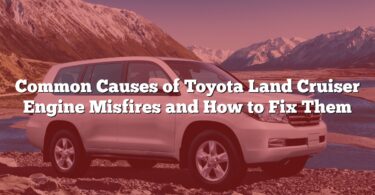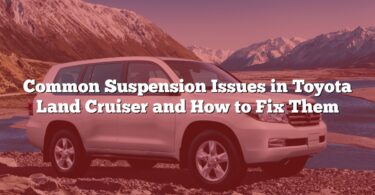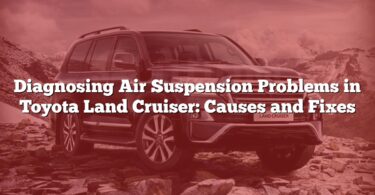When your Toyota Land Cruiser’s engine suddenly cuts out, it can be both frustrating and alarming. This guide dives into the most common reasons for this issue and provides practical solutions to get your vehicle running smoothly again. From fuel system troubles to sensor malfunctions, we’ll cover 45 possible causes and their fixes, helping you troubleshoot and prevent future problems effectively. Let’s get started on keeping your Land Cruiser as dependable as it was built to be.
Comprehensive Guide for Engine Cutting Out in a Toyota Land Cruiser: 45 Problems and Their Solutions
| N° | Problem/Cause | Solution |
|---|---|---|
| 1 | Dirty or clogged fuel injectors | Clean or replace the fuel injectors. |
| 2 | Faulty fuel pump | Inspect and replace the fuel pump if necessary. |
| 3 | Blocked fuel filter | Replace the fuel filter. |
| 4 | Air intake problems | Check and clear any obstructions in the air intake system. |
| 5 | Faulty mass airflow sensor (MAF) | Clean or replace the MAF sensor. |
| 6 | Malfunctioning throttle position sensor (TPS) | Test and replace the TPS as needed. |
| 7 | Faulty oxygen sensors | Replace the oxygen sensors. |
| 8 | Defective spark plugs | Inspect and replace spark plugs. |
| 9 | Worn ignition coils | Test and replace worn ignition coils. |
| 10 | Faulty distributor | Replace or repair the distributor. |
| 11 | Timing belt or chain issues | Inspect and replace the timing belt or chain. |
| 12 | Low engine compression | Diagnose and repair the internal engine components. |
| 13 | Faulty crankshaft position sensor | Replace the crankshaft position sensor. |
| 14 | Faulty camshaft position sensor | Replace the camshaft position sensor. |
| 15 | Battery issues | Check and replace the battery if needed. |
| 16 | Alternator failure | Replace the alternator. |
| 17 | Loose or damaged electrical connections | Inspect and secure or replace faulty connections. |
| 18 | Faulty engine control unit (ECU) | Reprogram or replace the ECU. |
| 19 | Overheating engine | Inspect the cooling system and repair any issues. |
| 20 | Low oil pressure | Check and refill or address leaks; inspect oil pump. |
| 21 | Contaminated or incorrect fuel | Drain and refill the fuel tank with the correct fuel. |
| 22 | Vacuum leaks | Identify and seal vacuum leaks. |
| 23 | Malfunctioning EGR valve | Clean or replace the EGR valve. |
| 24 | Sticking idle air control (IAC) valve | Clean or replace the IAC valve. |
| 25 | Faulty wiring harness | Repair or replace the wiring harness. |
| 26 | Immobilizer or security system issues | Reprogram or repair the immobilizer system. |
| 27 | Faulty temperature sensors | Replace faulty temperature sensors. |
| 28 | Water in the fuel system | Drain and clean the fuel system. |
| 29 | Exhaust system restrictions | Inspect and clear obstructions in the exhaust system. |
| 30 | Faulty catalytic converter | Replace the catalytic converter. |
| 31 | Diesel particulate filter (DPF) blockage | Perform forced DPF regeneration or replace the filter. |
| 32 | DPF additive system failure | Refill or repair the DPF additive system. |
| 33 | Faulty PCV valve | Replace the PCV valve. |
| 34 | Transmission-related issues affecting performance | Inspect and repair the transmission system. |
| 35 | Dirty or clogged air filter | Replace the air filter. |
| 36 | Torque converter failure (automatic transmissions) | Replace or repair the torque converter. |
| 37 | Software or firmware glitches in the ECU | Update or reflash the ECU software. |
| 38 | Broken or malfunctioning timing belt/chain | Replace or repair the timing system. |
| 39 | Incorrect sensor readings or calibration errors | Recalibrate or replace the affected sensors. |
| 40 | Insufficient driving conditions for DPF regeneration | Drive at higher speeds for longer durations to enable DPF regeneration. |
| 41 | Stalled regeneration of the DPF | Initiate forced regeneration at a dealership or mechanic. |
| 42 | Sensor failures leading to improper fuel-air mix | Diagnose and replace faulty sensors. |
| 43 | Fuel contamination or degradation | Clean the fuel system and refill with fresh fuel. |
| 44 | Ignition system failure | Test and replace ignition components. |
| 45 | Faulty or damaged exhaust gas recirculation (EGR) system | Repair or replace the EGR system. |
Detailed Guide for Engine Cutting Out in a Toyota Land Cruiser: 45 Problems and Their Solutions
1. Dirty or Clogged Fuel Injectors
Reason:
Fuel injectors spray fuel into the combustion chamber. Over time, they can become clogged with dirt or debris, leading to insufficient fuel delivery.
Solution:
- Use a high-quality fuel injector cleaner. Add it to your fuel tank as per the manufacturer’s instructions.
- If the issue persists, remove the injectors and clean them manually using specialized tools.
- Replace the injectors if cleaning does not restore proper functionality.
2. Faulty Fuel Pump
Reason:
A faulty fuel pump cannot deliver fuel to the engine efficiently, causing the engine to stall.
Solution:
- Test the fuel pump pressure using a fuel pressure gauge.
- If the pressure is below specifications, replace the fuel pump.
- Ensure that all electrical connections to the pump are secure.
3. Blocked Fuel Filter
Reason:
A blocked fuel filter restricts the flow of fuel to the engine, leading to performance issues or stalling.
Solution:
- Locate the fuel filter in your vehicle (usually near the fuel tank or under the hood).
- Replace the filter with a new one as per the maintenance schedule or whenever blockage is detected.
4. Air Intake Problems
Reason:
Obstructions in the air intake system reduce the airflow to the engine, disrupting the air-fuel mixture.
Solution:
- Inspect the air intake for debris or obstructions.
- Clean the intake system and replace the air filter if necessary.
5. Faulty Mass Airflow Sensor (MAF)
Reason:
The MAF sensor measures the air entering the engine. A faulty sensor sends incorrect data to the ECU, leading to improper fuel injection.
Solution:
- Clean the MAF sensor using MAF sensor cleaner.
- If cleaning doesn’t resolve the issue, replace the sensor.
6. Malfunctioning Throttle Position Sensor (TPS)
Reason:
The TPS monitors the throttle position and sends data to the ECU. A malfunctioning TPS causes poor throttle response and stalling.
Solution:
- Test the TPS using a multimeter.
- Replace the TPS if it is not operating within the correct voltage range.
7. Faulty Oxygen Sensors
Reason:
Oxygen sensors measure the oxygen level in the exhaust gases. A faulty sensor can disrupt the air-fuel ratio.
Solution:
- Diagnose the oxygen sensor using an OBD-II scanner.
- Replace any faulty sensors to restore proper engine function.
8. Defective Spark Plugs
Reason:
Worn or damaged spark plugs fail to ignite the air-fuel mixture, causing misfires or stalling.
Solution:
- Remove and inspect the spark plugs for wear or deposits.
- Replace with new plugs as per the manufacturer’s specifications.
9. Worn Ignition Coils
Reason:
Ignition coils amplify the voltage from the battery to fire the spark plugs. Worn coils result in weak or no sparks.
Solution:
- Test the coils using an ignition coil tester.
- Replace any coils that are not performing correctly.
10. Faulty Distributor
Reason:
The distributor delivers the spark to the spark plugs in a timed sequence. A faulty distributor causes misfires or stalling.
Solution:
- Inspect the distributor cap and rotor for cracks or wear.
- Replace damaged components or the entire distributor if necessary.
11. Timing Belt or Chain Issues
Reason:
A broken or misaligned timing belt/chain disrupts the synchronization of the crankshaft and camshaft, stopping the engine.
Solution:
- Inspect the timing belt/chain for damage or misalignment.
- Replace the belt/chain and adjust the timing according to the vehicle’s specifications.
12. Low Engine Compression
Reason:
Low compression in the cylinders reduces engine efficiency and may cause it to stall.
Solution:
- Perform a compression test on the engine.
- Repair or replace damaged valves, piston rings, or head gaskets as required.
13. Faulty Crankshaft Position Sensor
Reason:
This sensor monitors the position and speed of the crankshaft. A faulty sensor can disrupt ignition timing.
Solution:
- Use an OBD-II scanner to confirm the fault.
- Replace the sensor if it fails the diagnostic test.
14. Faulty Camshaft Position Sensor
Reason:
The camshaft sensor helps control fuel injection and ignition timing. A malfunction can cause the engine to stop.
Solution:
- Test the camshaft sensor using a multimeter.
- Replace the sensor if the readings are out of specification.
15. Battery Issues
Reason:
A weak or failing battery cannot provide adequate power to the ignition system and ECU.
Solution:
- Test the battery voltage using a multimeter.
- Recharge or replace the battery as necessary.
16. Alternator Failure
Reason:
The alternator charges the battery and powers electrical systems. A failing alternator leads to insufficient power for engine components.
Solution:
- Test the alternator output using a voltmeter.
- Replace the alternator if it’s not providing adequate charge.
17. Loose or Damaged Electrical Connections
Reason:
Loose or damaged wires can interrupt the flow of power to critical engine components.
Solution:
- Inspect the wiring harness and connections for damage or corrosion.
- Secure or replace faulty connections.
18. Faulty Engine Control Unit (ECU)
Reason:
The ECU manages all engine functions. A faulty ECU causes erratic engine behavior.
Solution:
- Reprogram the ECU with updated software.
- Replace the ECU if reprogramming does not resolve the issue.
19. Overheating Engine
Reason:
An overheating engine can shut down to prevent damage. This may be caused by a faulty cooling system, low coolant levels, or a broken thermostat.
Solution:
- Check the coolant level in the reservoir and refill if low.
- Inspect the radiator, hoses, and water pump for leaks or damage.
- Replace a malfunctioning thermostat.
- Ensure the cooling fans are working properly and replace them if needed.
20. Low Oil Pressure
Reason:
Low oil pressure can cause the engine to shut down to avoid damage due to insufficient lubrication.
Solution:
- Check the oil level using the dipstick and refill if necessary.
- Inspect for oil leaks and repair them.
- If the problem persists, check the oil pump and replace it if faulty.
21. Contaminated or Incorrect Fuel
Reason:
Contaminated or incorrect fuel disrupts combustion and may cause engine stalling.
Solution:
- Drain the fuel tank and refill with fresh, correct-grade fuel.
- Replace the fuel filter if contamination has spread through the system.
22. Vacuum Leaks
Reason:
Vacuum leaks disrupt the air-fuel mixture, causing rough idling or stalling.
Solution:
- Inspect the vacuum lines for cracks or disconnections.
- Replace damaged hoses or connectors.
23. Malfunctioning EGR Valve
Reason:
The Exhaust Gas Recirculation (EGR) valve controls emissions. If stuck open or closed, it affects engine performance.
Solution:
- Clean the EGR valve to remove carbon deposits.
- Replace the valve if cleaning doesn’t resolve the issue.
24. Sticking Idle Air Control (IAC) Valve
Reason:
The IAC valve controls the engine’s idle speed. A sticking valve can cause stalling during idle.
Solution:
- Remove and clean the IAC valve using a throttle body cleaner.
- Replace the valve if it continues to stick.
25. Faulty Wiring Harness
Reason:
A damaged wiring harness interrupts signals to and from the ECU and engine components.
Solution:
- Visually inspect the harness for frayed wires or damaged insulation.
- Repair or replace the affected sections of the harness.
26. Immobilizer or Security System Issues
Reason:
A malfunctioning immobilizer may prevent the engine from starting or running.
Solution:
- Reprogram the key fob or immobilizer system.
- Consult a dealer or locksmith to resolve deeper immobilizer issues.
27. Faulty Temperature Sensors
Reason:
Temperature sensors monitor engine temperature. A faulty sensor sends incorrect data, disrupting the engine’s performance.
Solution:
- Diagnose the sensor using an OBD-II scanner.
- Replace the faulty sensor with a new one.
28. Water in the Fuel System
Reason:
Water in the fuel system dilutes fuel, causing poor combustion and stalling.
Solution:
- Drain the fuel system completely.
- Add a fuel additive to remove any remaining moisture.
29. Exhaust System Restrictions
Reason:
Obstructions in the exhaust system restrict airflow, reducing engine performance.
Solution:
- Inspect the exhaust system for blockages, such as a collapsed pipe.
- Clear the obstruction or replace the affected parts.
30. Faulty Catalytic Converter
Reason:
A clogged or damaged catalytic converter restricts exhaust flow, causing the engine to stall.
Solution:
- Inspect the catalytic converter for damage.
- Replace the converter if it’s clogged or non-functional.
31. Diesel Particulate Filter (DPF) Blockage
Reason:
The DPF traps soot from the exhaust. A blocked DPF restricts engine performance.
Solution:
- Drive at highway speeds for 20–30 minutes to allow for automatic regeneration.
- If regeneration fails, perform a forced regeneration at a dealer.
- Replace the DPF if it’s damaged or beyond regeneration.
32. DPF Additive System Failure
Reason:
The DPF additive system helps in soot regeneration. If it fails, the DPF can clog.
Solution:
- Refill the DPF additive reservoir.
- Replace the additive pump or system components if necessary.
33. Faulty PCV Valve
Reason:
The Positive Crankcase Ventilation (PCV) valve removes gases from the engine. A faulty valve disrupts airflow and pressure.
Solution:
- Remove and clean the PCV valve.
- Replace the valve if cleaning doesn’t restore function.
34. Transmission-Related Issues
Reason:
Transmission problems can affect engine performance, especially in automatic vehicles.
Solution:
- Check transmission fluid levels and refill if low.
- Inspect and repair transmission components if required.
35. Dirty or Clogged Air Filter
Reason:
A clogged air filter restricts airflow to the engine, causing stalling.
Solution:
- Remove the air filter and inspect it for dirt or damage.
- Replace the filter if it’s dirty or worn out.
36. Torque Converter Failure
Reason:
A failing torque converter in automatic vehicles disrupts the engine’s connection to the transmission.
Solution:
- Inspect the torque converter for signs of failure.
- Replace or repair the converter if needed.
37. Software or Firmware Glitches in the ECU
Reason:
Outdated or corrupted ECU software causes erratic engine behavior.
Solution:
- Reflash or update the ECU software at a dealership.
- Replace the ECU if updates fail.
38. Broken or Malfunctioning Timing Belt/Chain
Reason:
A broken or misaligned timing belt/chain disrupts engine synchronization.
Solution:
- Replace the timing belt/chain with a new one.
- Realign the timing components as per specifications.
39. Incorrect Sensor Readings or Calibration Errors
Reason:
Sensors sending incorrect data lead to improper engine operation.
Solution:
- Diagnose and recalibrate sensors.
- Replace faulty sensors if recalibration doesn’t work.
40. Insufficient Driving Conditions for DPF Regeneration
Reason:
Short city drives prevent the DPF from regenerating.
Solution:
- Drive at speeds above 40 mph for at least 20 minutes weekly.
41. Stalled Regeneration of the DPF
Reason:
Interrupted regeneration leaves soot in the DPF.
Solution:
- Perform a forced regeneration at a professional service center.
42. Sensor Failures Leading to Improper Fuel-Air Mix
Reason:
Faulty sensors cause incorrect air-fuel mixtures, leading to stalling.
Solution:
- Test and replace faulty sensors.
43. Fuel Contamination or Degradation
Reason:
Old or contaminated fuel disrupts combustion.
Solution:
- Drain the fuel tank and refill with fresh fuel.
44. Ignition System Failure
Reason:
Failure in ignition coils or spark plugs disrupts combustion.
Solution:
- Replace faulty ignition components.
45. Faulty or Damaged EGR System
Reason:
A damaged EGR system disrupts emissions control and performance.
Solution:
- Inspect and clean the EGR system.
- Replace damaged components.
Preventing Future Issues
To ensure your Toyota Land Cruiser remains reliable and free from engine stalling, follow these preventative steps:
- Regular Maintenance
- Schedule routine maintenance as recommended in your vehicle’s owner’s manual.
- Replace filters (fuel, air, and oil) and fluids as required.
- Use Quality Fuel and Additives
- Always refuel with high-quality, recommended-grade fuel.
- Use fuel additives periodically to keep the fuel system clean.
- Monitor the Warning Lights
- Pay attention to any warning lights on the dashboard and address them promptly.
- Use an OBD-II scanner for early diagnostics of potential issues.
- Drive Regularly at Optimal Conditions
- Avoid frequent short trips, especially in diesel models with a DPF system.
- Drive at highway speeds (above 40 mph) for at least 20 minutes weekly to support DPF regeneration.
- Inspect the Electrical System
- Check battery health periodically and replace it before it fails.
- Ensure that all wiring connections are secure and free of corrosion.
- Keep Sensors and Valves Clean
- Regularly clean critical sensors such as the MAF and EGR valves to prevent performance issues.
- Protect Against Fuel Contamination
- Inspect the fuel tank for water or contaminants, especially after refueling at unfamiliar stations.
- Drain and clean the tank as necessary.
- Stay Ahead with Software Updates
- Check for ECU software or firmware updates during routine service visits.
By consistently following these steps, you can reduce the likelihood of engine problems, extend the lifespan of your vehicle, and enjoy a smoother driving experience.







